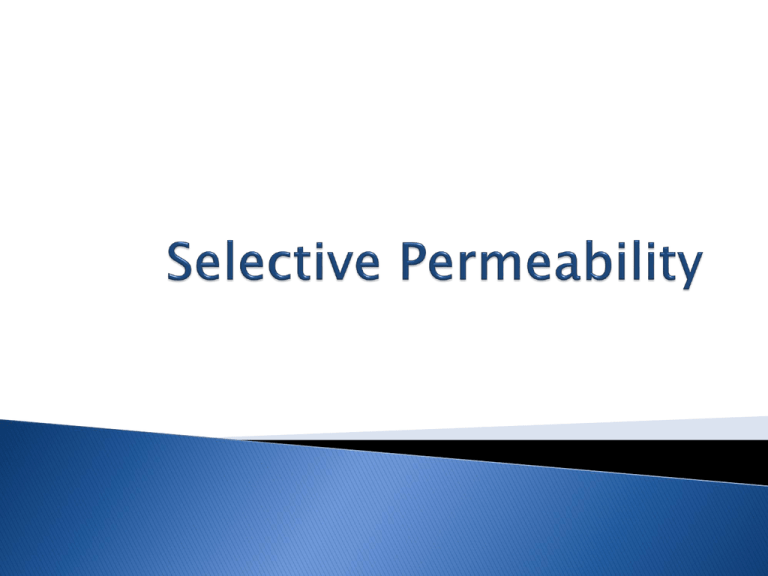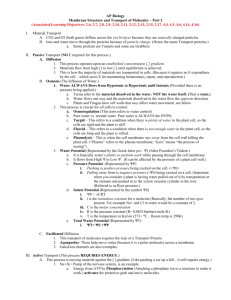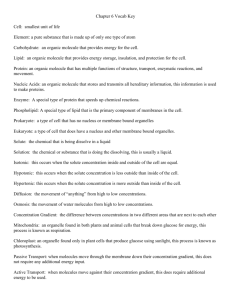Selective Permeability
advertisement

Aka semipermeable Means that the cell membrane allows some, but not all, molecules to cross. Small nonpolar molecules- don’t want to bond to anything so they slip through the membrane (CO2 and O2) Water- so small it slips through between the heads of phospholipids and the tails kick it out on the other side. Anything bigger or polar need special assistance. Receptors- proteins that detects a signal molecule and performs an action in response. ◦ Look for specific molecule then let the cell know the molecule has arrived. Ligand- molecule the receptor binds to 1. Intracellular Receptors- within cell Detects the important, small nonpolar molecules that cross the membrane Example: Hormones- bind to receptor, receptor takes it to nucleus to turn on genes in DNA to make specific proteins. http://highered.mcgrawhill.com/sites/0072507470/student_view0/chapter17/an imation__intracellular_receptor_model.html 2. Membrane Receptor- used for molecules that cannot cross the membrane Once the molecule binds to receptor, the receptor changes shape to announce its presence to the cell so cell can make appropriate response The selective permeable membrane allows some molecules to enter and exit cell without making the cell work Passive Transport- movement across cell membrane without cell using energy. Movement of molecules from a region of HIGHER concentration to a region of LOWER concentration Goal is to reach EQUILIBRIUMmolecules are all evenly spaced Note: molecules continue to move around but still stay spread out Concentration gradient- difference in concentration from one location to another HIGHER CONCENTRATION LOWER CONCENTRATION * Most molecules diffuse DOWN concentration gradient Moving from an area of high water concentration to an area of low water concentration Solutes = water concentration Solution outside the cell is compared to the inside of the cell The solution is isotonic to the cell if it has the same concentration of solutes as the cell Equal amounts of water are entering and leaving cell= cell size stays the same Has more solutes than the cell Low water, MORE SOLUTES Water leaves to the lower water concentration **water flows out of cell. Cell can shrivel up and die from lack of water More water outside of cell= water moves inside the cell More water, LOW SOLUTES Water enters cell. Cell has less water concentration **water is entering the cell, making it BIGGER What type of solution is each of these cells in? Diffusion of molecules across a membrane using TRANSPORT PROTEINS (channels and carrier proteins) Still PASSIVE transport because no energy is required. Molecules still moving DOWN, DOWN, DOWN, DOWN, DOWN the concentration gradient Channel proteins- transport polar molecules ◦ gated to regulate flow Carrier proteins- transport ions and larger molecules ◦ Have receptors that bind to specific molecule. ◦ When molecule is bound, the protein changes shape in order to release molecule to other side. Drives molecules across membrane AGAINST (UP) the concentration gradient Moves molecules from lower to higher concentration Proteins for active diffusion called Pumps Uniport- One molecule one way Symport- 2+ different molecules, same direction Antiport- 2+ different molecules, different directions Vesicles transport large substances without crossing through membrane ENDOCYTOSIS- taking large molecules INTO A CELL by engulfing them in a membrane. (like swallowing it) EXOCYTOSIS◦ Opposite of endocytosis ◦ Releasing substances OUTof cell by the vesicle fusing with the membrane and releasing its contents.






